Cool Yourself, Your Neighborhood, and the Planet with the Water-Harvesting Soil-Carbon Sponge
by Brad Lancaster
www.HarvestingRainwater.com
The following is reproduced from “Rainwater Harvesting for Drylands and Beyond, Volume 2, 2nd Edition.”
Life supported by water-harvesting earthworks mitigates climate change and weather extremes
The availability of more water within and beside water-harvesting earthworks grows more life, which in turn shades, cools, and shelters more of the Earth’s surface from intense sun, wind, flooding, and other extremes. There is a powerful, beneficial partnership between the hydrologic cycle circulating life-giving water and the carbon-based, soil-building, carbon-cycling life in the soil—known as the soil-carbon sponge. According to climate scientist and soil microbiologist Walter Jehne, the vast majority of the heat dynamics and hydrologic cooling on Earth is governed by our planet’s hydrologic cycle.1 And that cycle, coupled with the soil-carbon sponge, helps maintain a stable climate on our planet such that the amount of heat released to space is equal to incoming heat from the sun—though our planet has been holding onto more heat than it releases since about 1750 due to human-influenced climate change and the destruction of the soil-carbon sponge.2
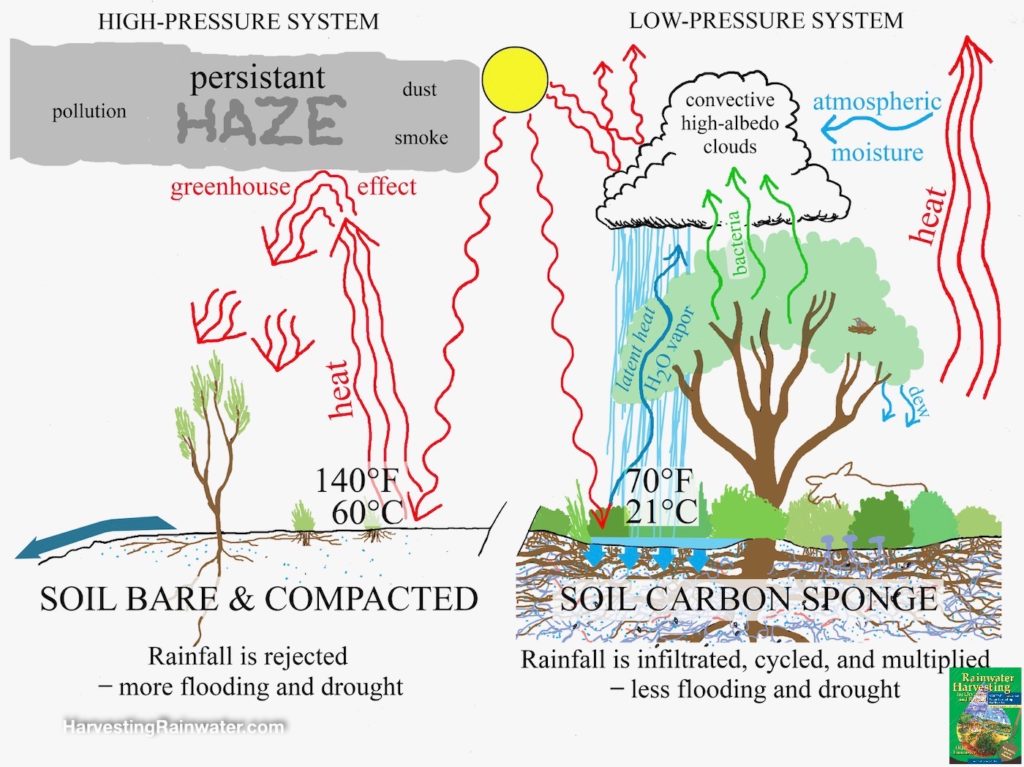
By understanding the synergy between the hydrologic cycle and the soil-carbon sponge, we can design our sites to beneficially collaborate with these natural processes. Well-vegetated soil absorbs and reradiates less heat to the atmosphere than non-vegetated bare earth. Evapotranspiration of water from this vegetation results in even more cooling because the latent heat/energy needed to change liquid water to water vapor is absorbed from solar radiation without increasing the air temperature. Water vapor rises into the atmosphere and collects around cloud “seeds”—precipitation nuclei—ideally tiny hydroscopic microbes or bacteria that grew in the stomata cavities of plant leaves and then were released into the air (so you could say rain is a microbial symbiotic process).3 The resulting clouds further shade the earth before the water vapor turns back into liquid rain drops, releasing energy/heat back into space. Rain from the clouds cools and rehydrates the earth’s surface, where soil-building, carbon-based life—the soil-carbon sponge—sequesters atmospheric carbon and rapidly infiltrates the water, which in turn supports more plant growth (figure 1). And more atmospheric moisture is invited into the area’s sky as the rainstorms release atmospheric pressure, creating a moisture-welcoming low-pressure system, rather than a moisture-deflecting high-pressure system.
The clouds created by the process described above are very different from haze, which is created by water vapor collecting around airborne dust particles, aerosols, and pollutants. Heat reflected off the earth’s surface up into the air is reflected back down to the earth’s surface by haze—the planet-heating greenhouse effect. Haze does not generate rain, so haze lingers much longer, and unlike clouds, which disperse after a storm enabling rising heat to escape to space (especially felt at night), haze does not disperse, but instead continues to trap heat in the atmosphere.
As Peter Donovan states in his essay “Recognizing the Soil Sponge,”
“Deforestation, fire, and agriculture have tended to move landscapes leftward (figure 1), baring soil, increasing fine dust particles that nucleate haze but not rain, planting short-season annuals, shortening the length of the green season and the sugary plant root exudates that feed soil porosity and aggregation. Bare soil heats up, radiates, and some of this heat is re-radiated back from greenhouse gases. Regular fire or tillage bares soil and prevents the soil carbon sponge from developing. High-pressure domes over large expanses of hot bare ground repel rain. These landscapes multiply heat and aridity.
On the right (figure 1), the formation of high-albedo rain clouds from abundant transpiration with bacterial precipitation nuclei helps recycle water locally, while the pressure drop from large-scale condensation drives the biotic pump, which brings in moist air from the oceans. When the clouds clear, heat can escape. Abundant plants harvest atmospheric moisture as dew (figure 2). More solar energy is dissipated upwards by transpiration, and less by sensible heat [heat that changes temperature]. These landscapes multiply rainfall and cooling…
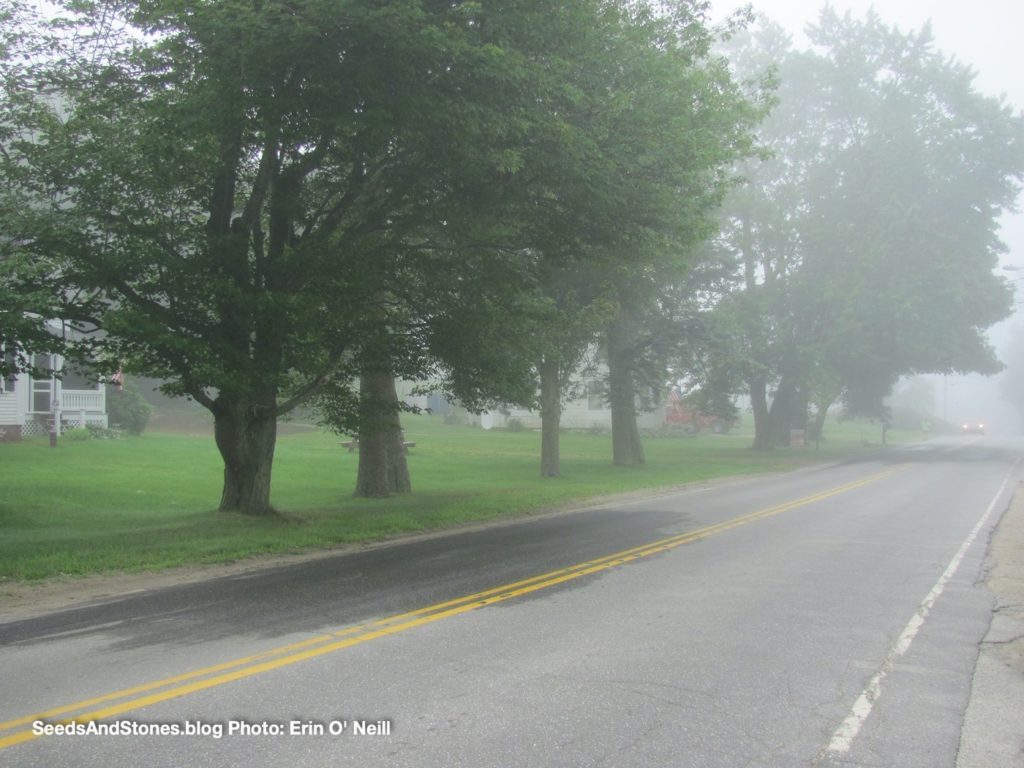
…Carbon embodies the solar-powered circle of life, the great biogeochemical carbon cycle powered by photosynthesis and governed by the metabolisms and choices of zillions of self-motivated living organisms, most of them microbes. Though the work of carbon cycling is tiny compared to the work of water cycling, carbon cycling wields enormous leverage with its complex and transformational chemistry, leading to a coupled carbon and water cycling that governs the balance between incoming solar radiation and outgoing long wave radiation. In the soil, the decomposition of living things forms the soil-carbon sponge, which can resiliently sustain plant life, affect the earth’s hydrology and heat balance, and may give humans the near-term leverage we need to avert catastrophic climate change, restore hydrologic function, maintain our economies and civilizations, and maintain and enhance human health.”4
Leaves are called “leaves” because we are supposed to leave them
Organic matter is food for the life of the soil-carbon sponge. So rather than rake or vacuum leaf drop out from under plants, why not leave it? This is made easier if we plant within or beside sunken water-harvesting earthworks or rain gardens, because organic matter—like water—will flow to the low spots. So go ahead and sweep fallen leaves off your patio, but reinvest those leaves in adjoining vegetated basins.
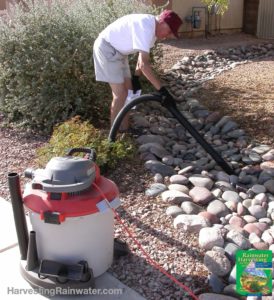
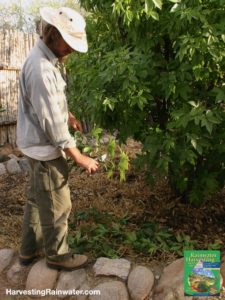
Increase available rainfall by increasing the catchment area from which you harvest the water
That organic matter will more quickly decompose and be consumed by the soil life if it, and the soil, is moist. Because water is a lubricant of exchange—in this case an exchange of nutrients. The more runoff we collect from adjoining hardscapes within our water-harvesting basins (and the greater the capacity of those basins), the more lubricant of exchange we’ll harvest; and the more we can grow the vegetative and soil-carbon sponge that can then shade, cool, and even seed those hardscapes.
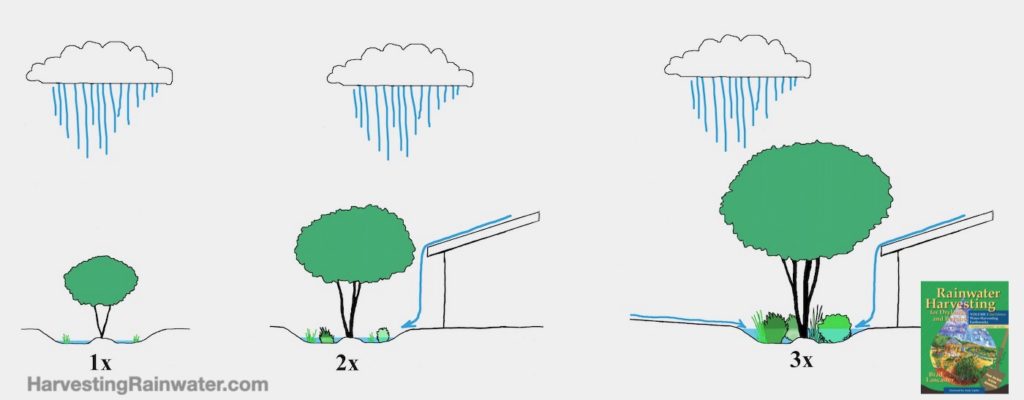
To absorb this in song form listen to:
Rainwater Spiritual, by Gabrielle Pietrangelo of Silver Thread Trio
REFERENCES
1. Jehne, Walter, “Regenerate Earth” http://www.globalcoolingearth.org/wp-content/uploads/2017/09/Regenerate-Earth-Paper-Walter-Jehne.pdf, accessed 2-8-2019
2. Jehne, Walter, “Restoring Water Cycles to Naturally Cool Climates and Reverse Global Warming,” presentation, November 2016, https://www.youtube.com/watch?v=K4ygsdHJjdI
3. Ibid.
4. Donovan, Peter, “Recognizing the Soil Carbon Sponge” https://soilcarboncoalition.org/recognizing-soil-carbon-sponge/ , accessed 2-8-2019
For more
See the new, full-color, revised editions of Brad’s award-winning books
– available a deep discount, direct from Brad:

Volume 1

